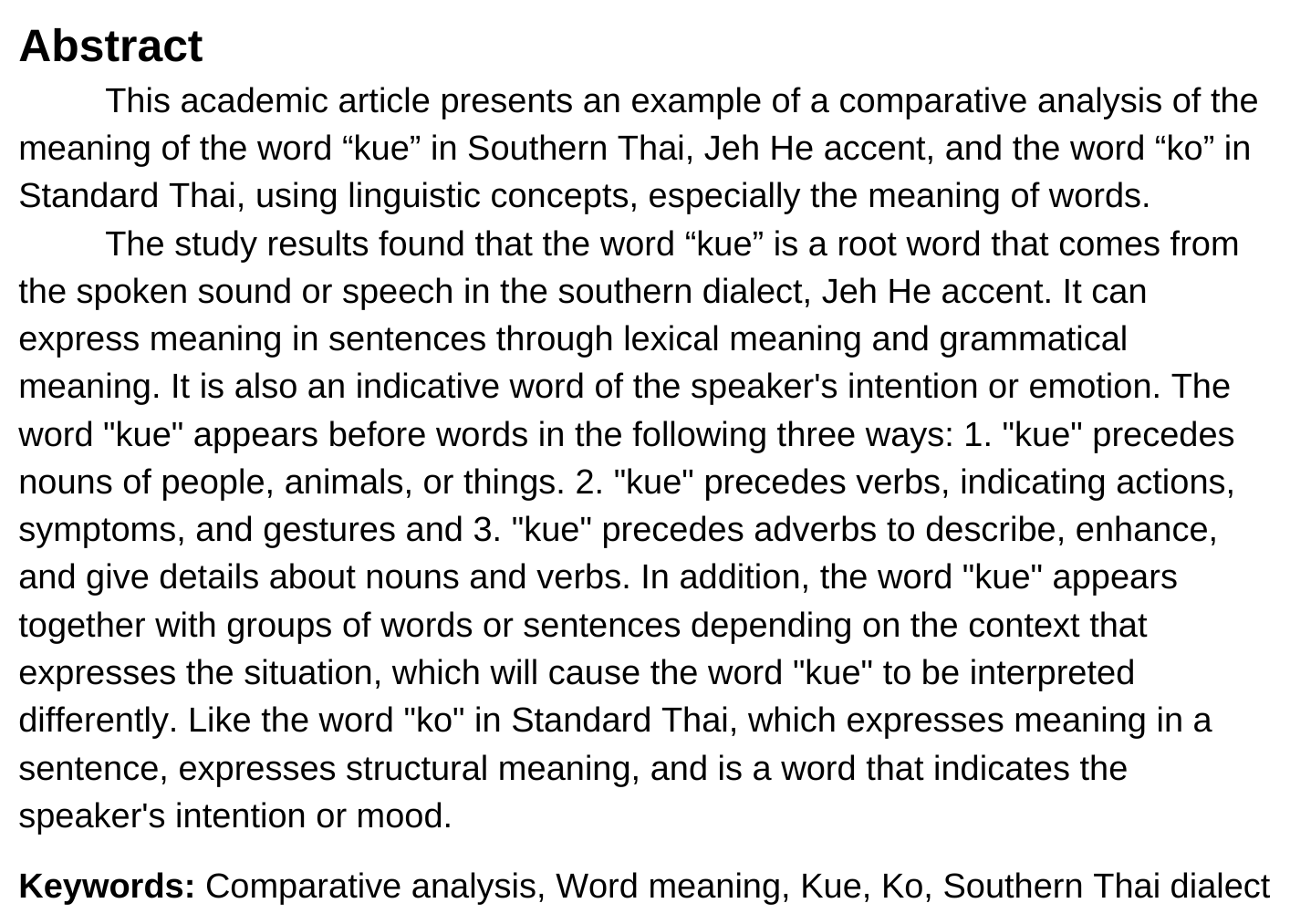The Comparative analysis of the meaning of the word "kue" in Southern Thai dialect, Jeh He accent, and the word "ko" in Standard Thai
Keywords:
Comparative analysis, Word meaning, Kue, Ko, Southern Thai dialectAbstract
This academic article presents an example of a comparative analysis of the meaning of the word “kue” in Southern Thai, Jeh He accent, and the word “ko” in Standard Thai, using linguistic concepts, especially the meaning of words.
The study results found that the word “kue” is a root word that comes from the spoken sound or speech in the southern dialect, Jeh He accent. It can express meaning in sentences through lexical meaning and grammatical meaning. It is also an indicative word of the speaker's intention or emotion. The word "kue" appears before words in the following three ways: 1. "kue" precedes nouns of people, animals, or things. 2. "kue" precedes verbs, indicating actions, symptoms, and gestures and 3. "kue" precedes adverbs to describe, enhance, and give details about nouns and verbs. In addition, the word "kue" appears together with groups of words or sentences depending on the context that expresses the situation, which will cause the word "kue" to be interpreted differently. Like the word "ko" in Standard Thai, which expresses meaning in a sentence, expresses structural meaning, and is a word that indicates the speaker's intention or mood.
References
กรมศิลปากร. (2545). วัฒนธรรม พัฒนาการทางประวัติศาสตร์ เอกลักษณ์ และภูมิปัญญาจังหวัดนราธิวาส. กรุงเทพมหานคร: โรงพิมพ์คุรุสภาลาดพร้าว.
ครื่น มนีโชติ. (2559). ภาษา: มรดกภูมิปัญญาทางวัฒนธรรมของชาติ. กรุงเทพมหานคร: โรงพิมพ์องค์การสงเคราะห์ทหารผ่านศึก ในพระบรมราชูปถัมภ์.
เฉลิม แสงสุวรรณ และชุม แสงมณี. (ม.ป.ป.). ตำนานเมืองเก่าโคกอิฐ. ม.ป.พ.
พุทธชาติ โปธิบาล และธนานันท์ ตรงดี. (2541). สถานะของภาษาตากใบในภาษาไทถิ่น (โครงการ - ระยะที่ 2). ปัตตานี : คณะมนุษยศาสตร์และสังคมศาสตร์ มหาวิทยาลัยสงขลานครินทร์.
พจนี ศิริอักษรสาสน์. (2554). ภาษาถิ่นของไทย. กรุงเทพมหานคร: สำนักพิมพ์มหาวิทยาลัยรามคำแหง.
วาริด เจริญราษฎร์. (2562). การแปรการใช้คำกริยาภาษาตากใบ (เจ๊ะเห) ตามระดับอายุของผู้ใช้ภาษาใน ตำบลเจ๊ะเห อำเภอตากใบ จังหวัดนราธิวาส. วารสารมหาวิทยาลัยราชภัฏธนบุรี, 14(1), 28–40.
วิจินตน์ ภาณุพงศ์. (2538). โครงสร้างของภาษาไทย. กรุงเทพมหานคร: สำนักพิมพ์มหาวิทยาลัยรามคำแหง.
วิยะดา สอ้านวงศ์. (2018). การแสดงความหมายของคำ "ก็" ในภาษาไทย. Language and Linguistics, 2(1), 46–68.
สุปรียา วิลาวรรณ. (2563). คู่มือการศึกษาชุดวิชา ภาษาศาสตร์เบื้องต้น (Introduction to Linguistics) โมดูลที่ 7 Semantics. นนทบุรี : สาขาวิชาศิลปศาสตร์ มหาวิทยาลัยสุโขทัยธรรมาธิราช.
สำนักงานวัฒนธรรมจังหวัดนราธิวาส และสภาวัฒนธรรมอำเภอตากใบ. (2566). สืบสานภาษาไทยถิ่นใต้ ภาษาถิ่นเจ๊ะเห อำเภอตากใบ. [ออนไลน์]. แหล่งที่มา : https://pubhtml5.com/yqiq/otfl/basic/ [10 มีนาคม 2568].
อภินันท์ ซื่อธานุวงศ์ และคณะ. (2555). ชื่อบ้านนามเมืองจังหวัดนราธิวาส. นราธิวาส: ม.ป.ท.
อุปกิตศิลปสาร, พระยา (นิ่ม กาญจนาชีวะ). (2541). หลักภาษาไทย (อักขรวิธี วจีวิภาค วากยสัมพันธ์ ฉันทลักษณ์). กรุงเทพมหานคร: ไทยวัฒนาพานิช,
Brown, J. M. (1965). From ancient Thai to modern dialects. Michigan: The Social Science Association Press of Thailand.
Diller, Anthony V.N. (1976). Toward a Model of Southern Thai Diglossic Speech Variation. Ph.D. Dissertation. Cornell University.
Li, F. K. (1960). A tentative classification of Tai dialects. In S. Diamond (Ed.), Culture in history: Essays in honor of Paul Rodin (pp. 951–959). New York: Columbia University Press.

Downloads
Published
How to Cite
Issue
Section
License
Copyright (c) 2025 Institute of Sufficiency Journal

This work is licensed under a Creative Commons Attribution-NonCommercial-NoDerivatives 4.0 International License.



